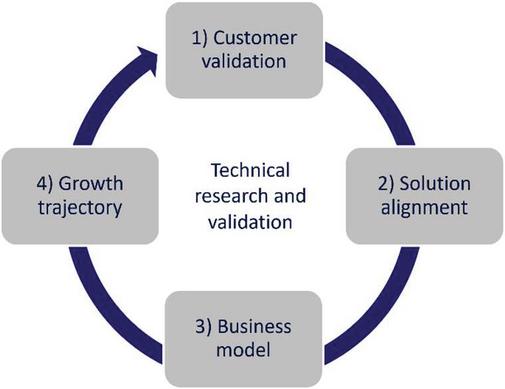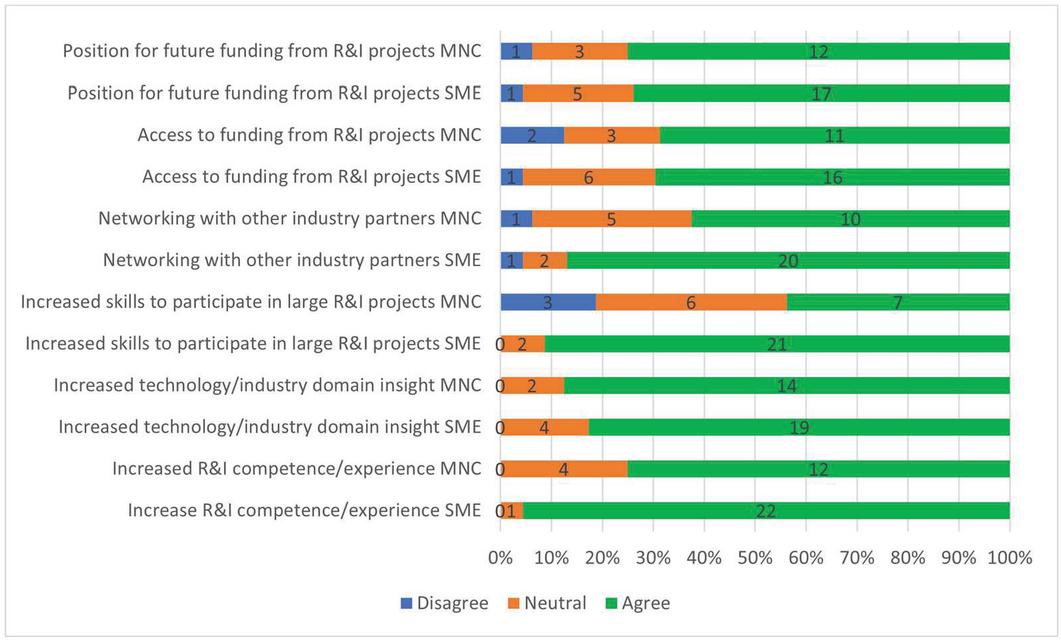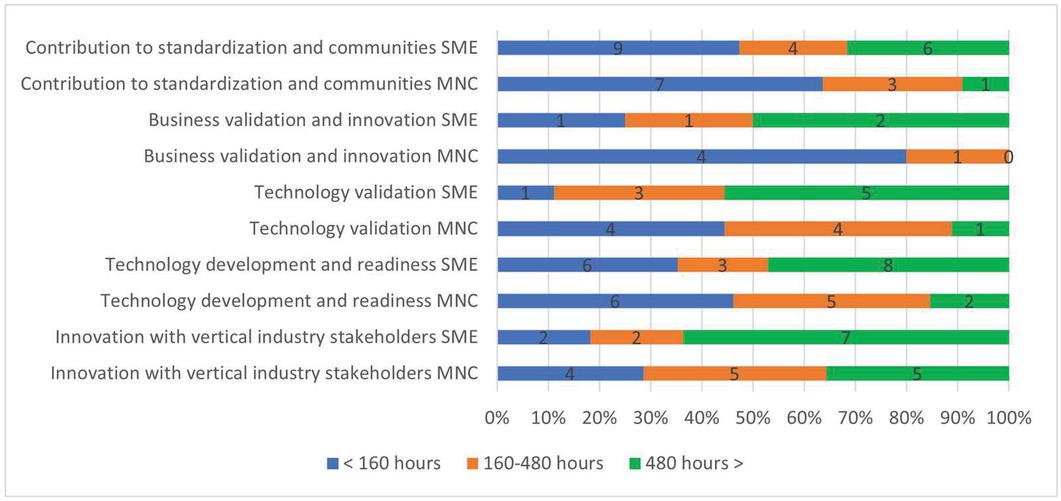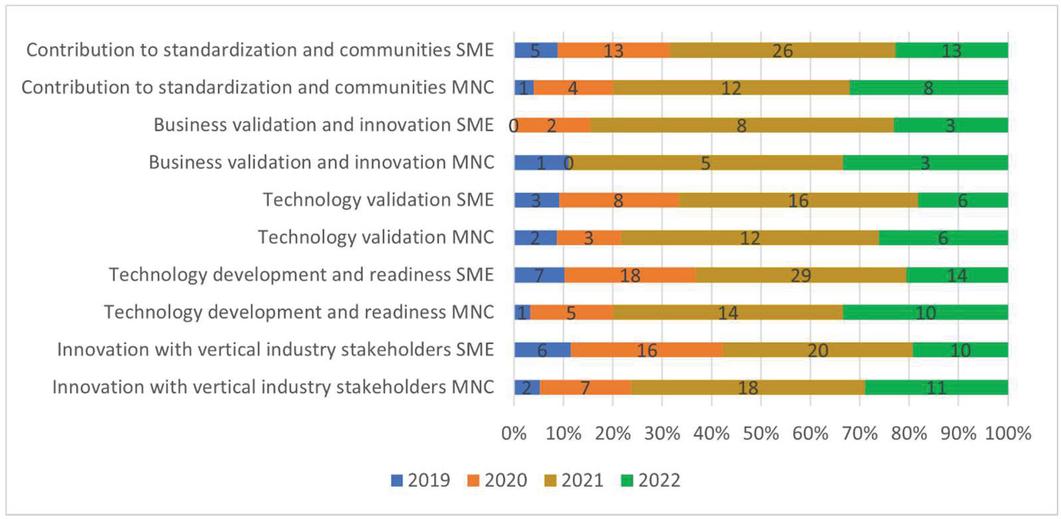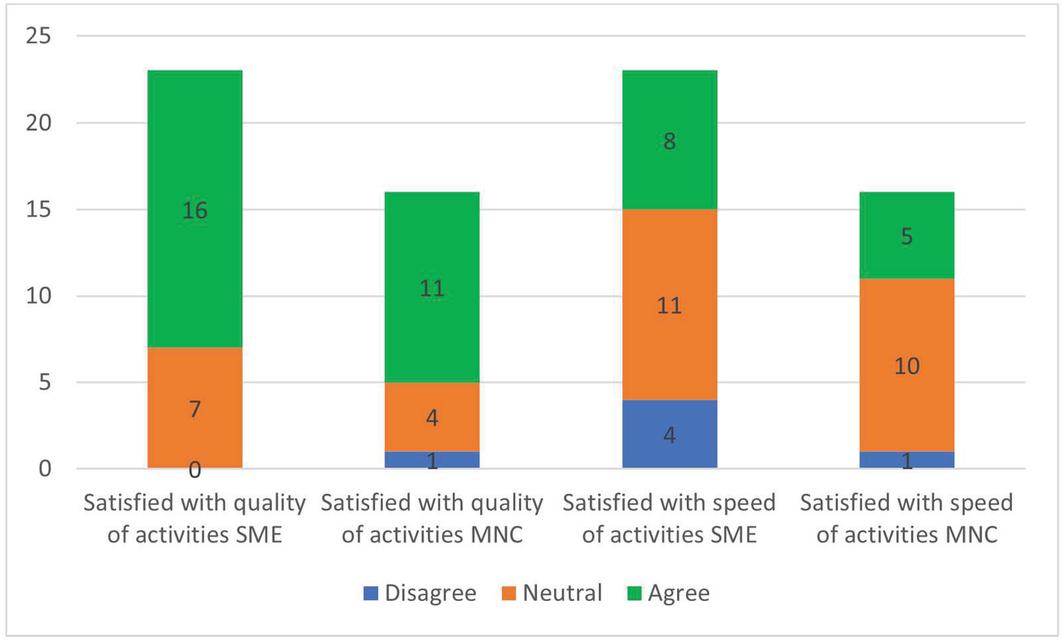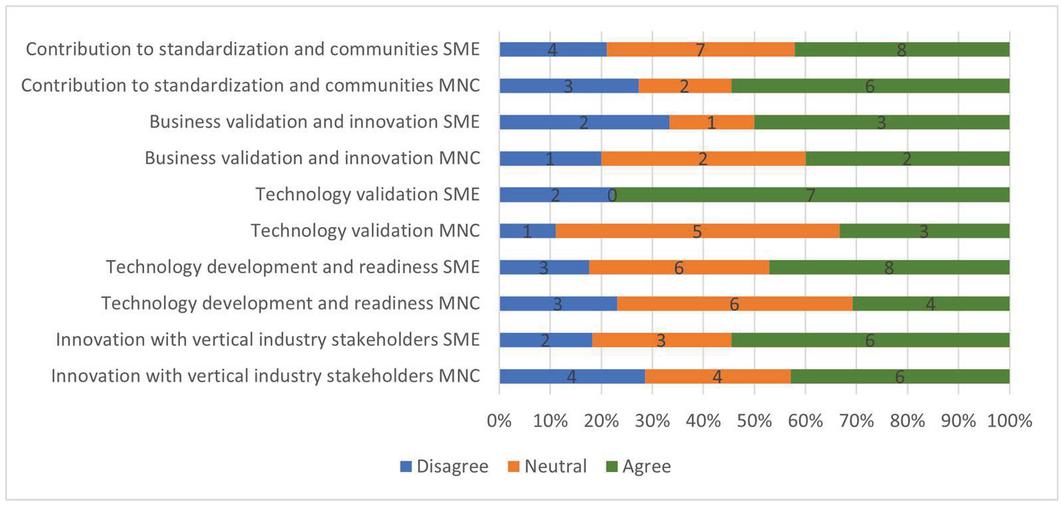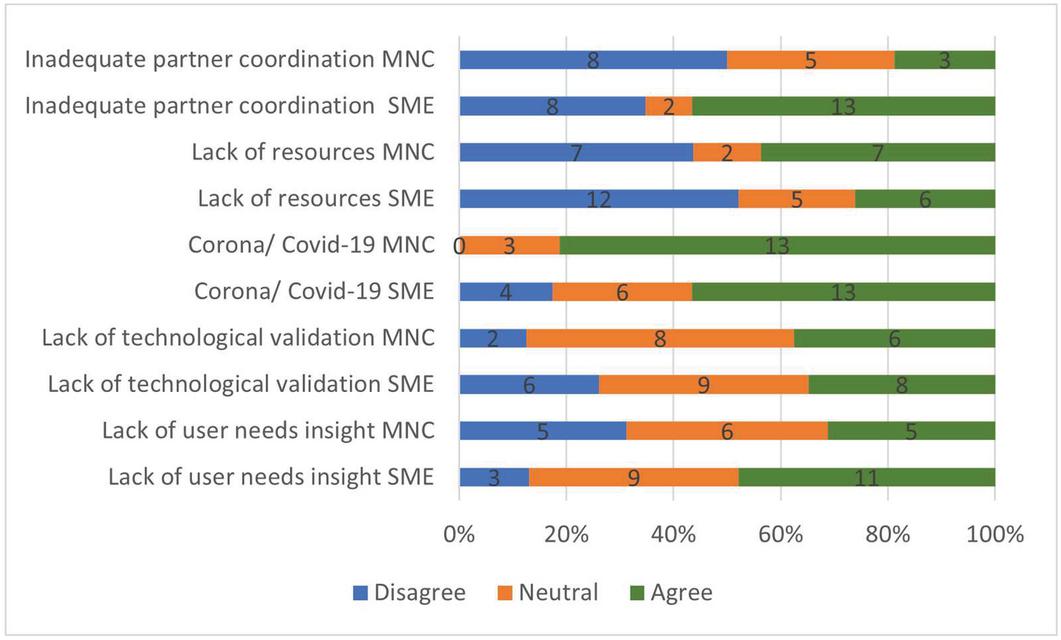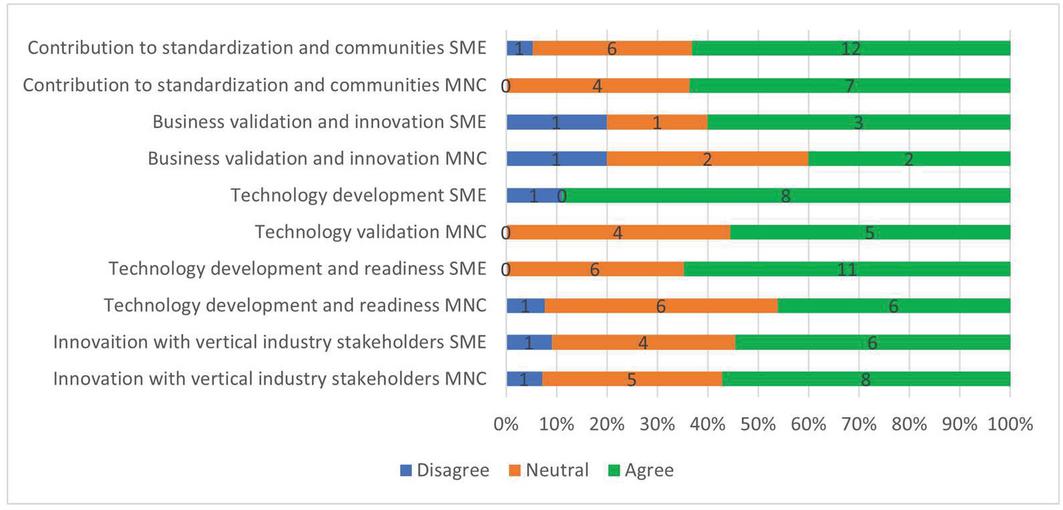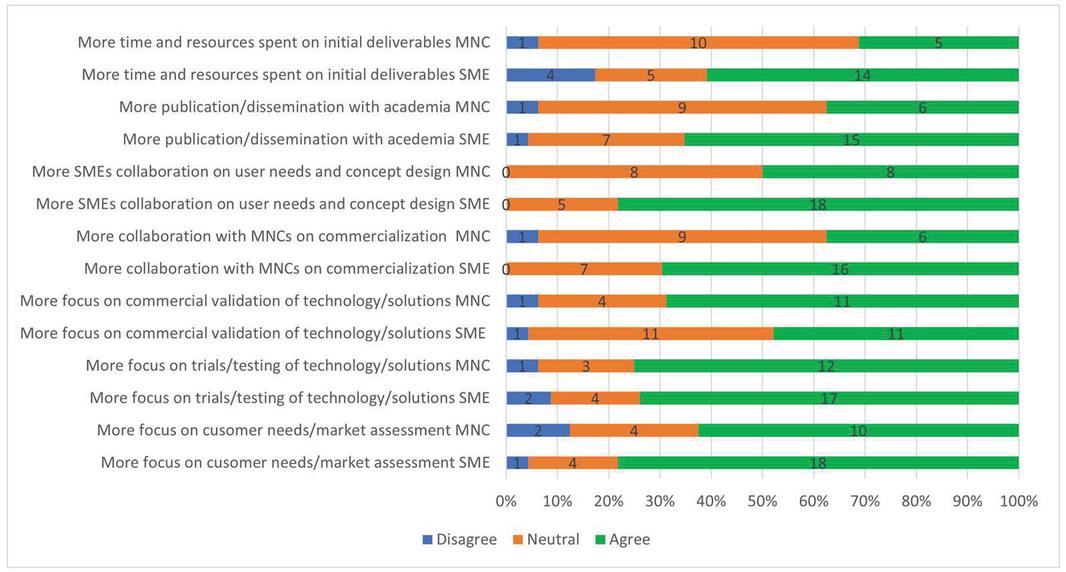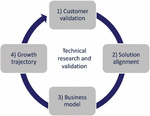Activities and Outputs from SME and MNC Collaboration on R&I Projects
Per J. Nesse1,* and Kristoffer Opsahl2
1Telenor Research and Innovation and Norwegian University of Science and Technology, Trondheim, Norway
2Norwegian University of Science and Technology, Trondheim, Norway
E-mail: Per-jonny.nesse@telenor.com; post@opsl.no
*Correspondng Author
Received 08 July 2022; Accepted 01 May 2023; Publication 18 May 2023
Abstract
The fifth generation (5G) of telecommunication systems is creating new business opportunities for many industry verticals. Managing the innovation process is risky and calls for collaboration with various ecosystem stakeholders to meet the demands of technology, business, and customers. This article investigates the activities and output of participation in collaborative research and innovation (R&I) activities for Small and Medium Sized Enterprises (SMEs) and Multi National Corporations (MNCs) and how they engage with such activities. A survey was conducted with a non-random sample of 42 respondents involved in R&I projects and further supplemented with three in-depth interviews of a subset of the survey respondents. Our key findings indicate that SMEs benefit from technology-related activities and access to decision makers in MNCs. Heavy-handed bureaucracy in projects is a friction point for SMEs, which prefer development speed over scheduled reports and deliverables. In contrast, MNCs benefit from business-related activities by advertising technology to clients, suppliers, and downstream business models. Suggested improvements include additional client needs assessments, trialing of technology and service concepts, and dissemination of the results of R&I activities. SMEs and MNCs view establishing relationships with other partners as valuable for accessing key competencies and vertical industry ecosystems. Our findings provide novel insight in the collaboration of R&I projects with SMEs and MNCs and contributes to the business ecosystem and open innovation literature. Further research should include follow-up studies of the SME–MNC collaboration towards commercialization of innovative 5G use cases.
Keywords: R&I, research and innovation, collaboration, SME, small and medium enterprise, MNC, multi national corporation, 5G, agile methodology, business ecosystem, open innovation.
1 Introduction
When the European Commission (EC) established the 5G Private Public Partnership (5G PPP) agreement with the European information and communication technology (ICT) industry in 2013, they targeted 20% of the 5G PPP funding to go to SMEs [1], acknowledging their importance in the R&I ecosystem. Significant economic and social value is expected to be generated from use case innovations activated by 5G [2, 3]. Hence, it is necessary to validate the technical feasibility and business impact of these use case innovations developed by the consortium partners. Developing these use case innovations in ecosystems of private and public partners secures access to various insights and best practices. The partner shares the risk and resources necessary to drive the process from idea to commercialization [4, 5].
A previous systematic review of relevant literature identified a research gap on the SME perspective in collaborative R&I projects [6]. The literature review was initially concerned with the usage of Agile development methodologies in the context of open innovation [7], as well as their role in the triple helix ecosystem [8]. The review identified a research gap regarding the interaction between SMEs and collaborative innovation activities. Although one study did investigate which incentives exist for SMEs to participate in such activities, the research did not describe the nature of participation [9].
Surveying and interviewing respondents regarding 5G-SOLUTIONS [10], one of the 5G PPPs, is needed to understand how different stakeholders, SMEs and MNCs in particular although public institutions are also involved, interface with the same collaborative innovation project. The following research questions summarize the goals of this study:
• How do SMEs and MNCs comparatively engage with collaborative R&I activities?
• What do SMEs and MNCs perceive to be the outputs of participating in collaborative R&I activities, and what are the potential improvements for boosting these outputs?
2 Theory
Traditionally, research has focused on open innovation (OI) in large enterprises active in R&I-intensive industries. Through inflow of technologies and products and outflow of patents and spin-offs, MNCs have gained access to new tools for managing innovation successfully [11]. There is now an increasing trend in publications on OI in SMEs arguing that they need to open up more than their larger counterparts to access external knowledge and technology for innovative purposes [12]. Moreover, SMEs represent important players in the European innovation landscape. Almost one-third (27%) of SMEs introduce innovative products or services [13]. On average, 41.6% of SMEs have innovated by introducing innovative business processes. However, on average only 11.7% of SMEs collaborate with others in their innovation activities [13]. Large enterprises are here defined as enterprises with 250 or more employees, whereas SMEs are defined as enterprises with 10 to 249 employees [14]. Lately, the participation of SMEs has become a key criterion in the evaluation of grant proposals for research and technological development projects funded by European Union (EU) [15].
Through research partnerships, SMEs can gain access to (1) complementary knowledge residing in innovation partners; (2) intangible tacit knowledge and know-how, which cannot easily be contracted through market transactions; and (3) economies of scale and scope in both research and development, thus reducing innovation costs [16]. Such partnerships can involve customers, suppliers, competitors, universities, public research organizations, consultants and professional and industrial associations. Spithoven et al. [17] compared OI practices among innovating SMEs and large enterprises via a largescale survey in Belgium. They found that OI has a positive effect on the introduction of new offerings for both SMEs and large companies. However, SMEs had a much higher intensity (i.e., ratio of OI activities to employment) for all types of OI activities than large companies, and they benefited relatively more from the use of intellectual property protection than large firms.
Radziwon and Bogers [18] explored how SMEs collaborate with other organizations in a regional ecosystem context. They studied seven manufacturing SMEs as well as a few large companies. They found that SMEs and large enterprises had different perspectives and focuses and placed different values on joint projects. Therefore, they might not treat one another as partners. However, SMEs viewed suppliers in the ecosystem as very important partners because they could help SMEs develop and deliver value to the customer. The authors suggested setting clear goals and business objectives for the whole ecosystem in order to mitigate such challenges.
Grimpe et al. [19] studied innovation action project proposals with SME participation funded by the EU’s Horizon 2020 program. These project consortiums are similar to 5G-SOLUTIONS in that they involve large firms, universities and research institutions, public bodies and non-governmental organizations. The results of the content analysis of 207 projects showed that the composition of the consortia affected the research priorities. Diverse consortiums pay three times as much attention to the innovation ecosystem (access to complementary assets and spillover effects to partners) and commercialization (defining new markets for the intended innovation) at the expense of technological novelty. However, this study did not separate responses from SMEs and large firms/other partners.
Prashantham and Birkinshaw [9] claimed that there are three major obstacles to SMEs and MNCs working together: (1) lack of access and attention, (2) different longterm objectives and (3) asymmetry in resources. Based on a study of small software enterprises in India and the United Kingdom, they suggested a three-step strategy for partnering. One strategy is for SMEs to “plan for the short term with an eye on the long term” through product prototyping, demonstrating the value proposition and utilizing their skills and knowledge. Moreover, they advised that SMEs with cuttingedge technologies and global ambitions for their products should utilize MNCs’ networks for scale and reach.
The triple helix model describes how innovations are created by three major ecosystem actors: business, government and academia [5]. Others suggest there is demand for entrepreneurs starting new businesses and risk-tolerant private investors who take on the financial risk of new companies [20]. SMEs are attractive partners and suppliers for large firms due to their size, focus, business specification, entrepreneurial activities and speed [21]. Their sharp focus on a particular market, customer type, expertise or technology generates a sustainable competitive advantage. Moreover, SMEs often embody important innovation experiments in technologies or business models, which could teach a great deal to observant large firms.
The concept of the fuzzy front end is related to uncertainty around the customer (e.g., preference, portfolio, life cycle and volume), technology (e.g., supply, specification and materials) and competition (e.g., product development and technology adoption) early on in innovation projects. This uncertainty negatively impacts their success but can be mitigated by involving customers and suppliers during the innovation process, hence reducing risk [22]. The lean build-measure-learn (i.e., develop, prototype and test) approach when developing early solution prototypes, i.e., minimum viable products (MVPs) can secure the process of learning as quickly as possible to get a desirable product to customers’ hands faster [23]. This work is supported by Cooper [24–26] through his iterative, Agile and open innovation modifications of the original stage-gate model. Still [27] suggested a similar lean start-up-based innovation methodology for R&I activities for universities and other public research institutes, mitigating the high degree of failure in translating scientific advances into marketable innovations.
A “keystone” [28] or platform leader [22] is the core actor of an ecosystem, while the more minor actors are called niche or complementary players [29]. These actors integrate the keystone’s platform into their software, applications, products and services [30], enabling innovation and solutions across the ecosystem by opening their interfaces to others [31]. The role of the keystone is to contribute to the ecosystem’s health and thus affect both their own and other players’ success [32]. Whether the industry or telecom stakeholder improves the ecosystem’s health or not can be measured by its degree of performance (financial metrics) [33], robustness (survive disruptions) and diversity [34] through the creation of innovative niche products and services. Competition between the platform leader and its partners in the R&I consortium can be mitigated with a collaborative governance model that motivates innovation in the best interests of the platform and the total ecosystem [35].
Summing up, there are numerous benefits to SMEs and MNCs innovation processes for collaboration with complementary ecosystem partners [4, 29], including shared spending and risk on innovation, access to new ideas or concepts, shared physical and intellectual assets, and the potential to gain customers through referrals or recommendations. The benefits of lean and Agile are increased productivity, improved product quality, better project control, higher customer satisfaction, faster return on investment, and continuous improvement [23]. However, exploiting OI benefits may be challenging due to a lack of clear ownership, risk of losing intellectual property rights and business model inertia [4]. In addition, MNCs and SMEs have different intentions regarding their desired output from the collaboration activities. Although the OI and triple helix framework produce win-win solutions for ecosystem actors on a conceptual level, they still lack practical guidance on the innovation use case level.
3 Methodology
This research utilized a descriptive cross-sectional study [36], as it was deemed the most suitable approach for the research questions at hand, and the best way to complement the existing body of research.
3.1 Data Collection and Analysis
Data collection was done in three ways. First, a systematic literature review [6] formed the basis for the article’s research questions. Further, a limited literature review was conducted for this article, mainly to contextualize the research questions concerning existing research in a stand alone manner.
The process of acquiring data on collaboration in the innovation ecosystems was twofold, consisting of an online survey and in-depth interviews with selected stakeholders (Table 1).
Table 1 Description of data sources
| Method | Information Sources |
| Survey study of 5G R&I projects (Spring 2022) |
– Invitation to join survey distributed to 5G-SOLUTIONS and 5G PPP SME working group (WG) stakeholders using the EU’s survey service. Reminders posted. – Out of 42 responses from employees at 5G-SOLUTIONS SMEs and MNCs, three who did not report any collaboration with consortium partners were excluded. |
| Interview with 5G R&I project partners (Spring 2022) |
– Interviews (video calls) with project managers and specialists (five people). – Two SMEs and one MNC from the same 5G R&I (5G-SOLUTIONS) project were selected. |
The invitation to join the online survey was distributed to 5G-SOLUTIONS partners, 5G PPP SME WG members and private companies that had previously participated in different webinars arranged by 5G-SOLUTIONS. The survey yielded 42 responses, of which 24 and 18 were from employees of SMEs and MNCs, respectively. Thirty-nine respondents stated to were involved in R&I projects and (in one or more activities) in the 5G-SOLUTIONS project. The SMEs included in the survey ranged from six to 70 employees (50%), while the MNCs were primarily large corporations with over 250 employees (43%). Most respondents came from the information and communication sector (55%) followed by the scientific and technical service sector (17%). The remaining respondents were from the manufacturing, electricity and agriculture sectors. 5G-SOLUTIONS [10] is a project that aims to validate (technologically and businesswise) different use case innovations with vertical domains such as Industry 4.0. It has 26 different ecosystem partners and the project is scheduled to terminate in the fall of 2022. One of the specialists we interviewed as preparation for the SME and MNC interviews was from the 5G PPP SME workgroup. This is a cross-5G project group that aims to promote the skills of SMEs in the telecommunication domain, especially among larger companies and research organizations [1]. Three interviews were also conducted with strategically selected partners from the 5G-SOLUTIONS project [36]. The purpose was to provide SME and MNC perspectives and in-depth insights on the R&I activities and the administrative side of collaborative activities. Thus, we applied multiple data sources in this case study in accordance with the triangulation principle described by Yin [36] and Bryman and Bell [37].
Analyzing the survey findings, we transformed the five-element Likert scale into three elements: agree, neutral, and disagree. The answers for each question were combined into a single figure, featuring data from both SMEs and MNCs. Because the number of SME and MNC respondents differed, relative distributions were reported. The actual number of responses per element (agree, neutral and disagree) were also included in the same figure. Some questions allowed respondents to select multiple alternatives per response.
Figure 1 5G-SOLUTIONS Agile development methodology.
3.2 Agile Methodology in 5G-SOLUTIONS
Figure 1 illustrates the Agile methodology applied for 5G-SOLUTIONS by 20 use cases in four living labs [38]. The methodology is inspired by the lean startup [23] and innovation acceleration [27] models.
1. Customer validation: Define the specific customers and other stakeholders (personas) involved and describes the most important problems, needs and pains they experience with the products and solutions currently available.
2. Solution alignment: Develop and tests 5G-enabled solution MVPs based on requirements extracted from use case stakeholders on needs and pain points. A subset of use case solutions within the different industry verticals/living labs will be clustered/aligned around a joint solution that consortium actors can commercialize in the vertical marketplace.
3. Business model: Develop a win-win business model for customers and stakeholders for the clusters of use cases from each industry vertical/living lab.
4. Growth trajectory: Develop viable business plans for commercialization of the most exploitable 5G use case solutions offered in the market. This plan is executed by a lead stakeholder within the vertical and supported by other 5G-SOLUTIONS partners based on their ecosystem roles.
Customer and business validation go hand in hand with technological validation throughout three predefined development and trial cycles during the project. The impact of solutions on relevant communication technologies and protocols/standardization bodies is also included. Technical research and validation focus on the performance of the early versions of solutions developed (prototypes/MVPs). This involves 5Gnetwork related parameters such as latency, capacity, speed, coverage and reliability. The customer and business validation parameters are related to increased profits, user experience, health and safety and social acceptance [39, 40].
5G-SOLUTIONS projects began in fall 2019, and the planned termination was three years later, in fall 2022. However, due to delays, the project will end in spring 2023.
4 Findings
Here we present the findings from the survey performed among the partners participating in the 5G-SOLUTIONS R&I project. In addition, we include interview quotes from some select partners.
Figure 2 Reasons for participating in inter-organizational collaborative R&I projects.
4.1 Intentions
The intentions for participating in inter-organizational R&I projects differ somewhat between the SMEs and MNCs (Figure 2). SMEs’ top three reasons for participation were:
1. Increased research innovation competence and experience.
2. Increased skills in participating in large R&I consortiums.
3. Getting to know and learning how to network with other industry partners.
4. Access to funding of R&I projects was ranked next.
For MNCs, the top reasons for participation in R&I projects were:
1. To gain increased knowledge on relevant technology and industry domain insight.
2. Access to funding for current and forthcoming R&I projects.
3. Increased skills in participating in large R&I projects.
4.2 Hours Spent
For the SMEs, the activities that were reported to consume the most time were innovation with vertical industry stakeholders followed by technology development and validation (Figure 3). Spending hours on business validation was mentioned less often. Standardization was reported to take the least amount of time. The MNCs also reported that the most hours were spent on innovation with vertical stakeholders and technology development and validation, although they spent less time on this than SMEs on average. MNCs most frequently reported spending less than 160 hours on business validation activities.
Figure 3 Time spent participating in types of activities.
Figure 4 shows participation in cross-functional activities since 2019. The majority of activities happened during 2021 for SMEs and MNCs. For the MNCs, this included technology development, standardization and the innovation with vertical industry stakeholders. SMEs and MNCs performed commercialization activities throughout 2022.
Figure 4 Periods of project participation in types activities.
Portfolios of interconnected commercial and technological activities performed with each other during the R&I project indicated a steady rotation of individuals committed to a project during different phases of development. One SME confirmed the high turnover rate of personnel in the following statement:
“It was just too many people, too many companies, and it went on for too long, so it was tough to keep momentum. Multiple partners have even changed key personnel interfacing with the project.” (SME1)
4.3 Quality and Speed
SMEs and MNCs were mostly satisfied with the quality of activities executed (Figure 5). However, their satisfaction with the speed of the activities differed.
Figure 5 Satisfaction with the quality and speed of activities.
The perception that meticulousness was prioritized at the cost of speed was consistent with the following statement by an MNC interviewee, who was from the organization most suited to thrive in a complex project environment:
“The complexity involved makes it hard to plan the process across all steps, as the final output will often diverge significantly from what was initially planned.” (MNC)
Figure 6 shows that the scope of the activities has not been unnecessarily or hindered by artificial constraints. SMEs and MNCs indicates that the resources committed to enforcing specific standards at certain points in the project were excessive, which is consistent with the data from Figure 5, which showed greater satisfaction with activity quality than speed. The SMEs also acknowledge the predefined scope of the project with respect to the technology validation activities. However, one of the SMEs interviewed point out the negative effects of reporting and joint meetings related to the different activities performed:
“The second thing is the number of deliverables and the number of meetings. I have never seen a project with that large amount of reporting effort. I think this negatively affects the effectiveness and efficiency of implementation. And it needs to be simplified for the next project, because otherwise, we stay all the time reporting, reporting, reporting, without actually doing.” (SME2)
Figure 6 Activities driven by company preferences rather than deadlines.
4.4 Delays
Both the SMEs and MNCs agreed that the COVID-19 pandemic was the main reason for the delays to the 5G-SOLUTIONS project (Figure 7). Here, interviewees were unanimous in their concerns, confirming the idea that it adversely affected coordination:
“COVID-19 certainly was a factor, and I feel there was much more creativity and collaboration in the project’s first year, meeting face to face. Those meetings were great for building relationships and networking, and then COVID-19 limited the project’s spirit to a degree.” (SME1) “It was a pity we had the COVID-19 issue that caused people only to meet electronically, which is again a limitation for both dissemination and mutual understanding. This project’s significant advantage is putting people of different professional backgrounds together.” (MNC)
However, the companies disagreed somewhat with respect to other causes of delay. The MNCs agreed that a lack of resources (man hours) and lack of validation of key performance indicators (KPIs) were the other main causes for delay. The SMEs agreed inadequate coordination with other project partners and lack of insight into user needs and requirements were the second and third most important reasons for delay.
Figure 7 Perceived reasons for major delays.
SMEs also indicated that the planning of project deliverables was an inherent reason for the delays:
“When you want to achieve many goals, you cannot plan the entire project in the first phase. Sometimes you do not expect certain intermediate results. Like in this project, we did not expect low performance on the provided equipment. Luckily we managed to mitigate the issues and continue the project. Nevertheless, in some other cases, with some goals depending on others, you can potentially lose parts of the project.” (SME1) “I think the project has too many internal dependencies. We have had several phases where participating in a phase requires high-quality output from the previous phase, all of which were planned at the start of the project. There is also a discrepancy where the planning has been very abstract and theoretical while not allowing for the accommodation of issues that might arise during implementation, thus ensuring that adhering to contractual obligations has been less smooth than we expected.” (SME2)
Figure 8 Usefulness of activity outputs for SMEs and MNCs.
With respect to SMEs reporting inadequate coordination with their collaborative partner, this was related to a lack of continuity between distinct phases of the project:
“In the initial phase of the project, we participated in the design of the equipment, and we actively collaborated with many partners, but after the production-environment prototype, we lost contact with both the development and usage sides of the technology.” (SME1)
4.5 Output
The SMEs reported that the most important output from the project was related to technology development and contribution to standards (Figure 8). The MNCs reported that the most important output was innovation with vertical stakeholders.
By conducting in-depth interviews, a more detailed understanding of the outputs and advantages of the 5G-SOLUTIONS R&I project for both MNCs and SMEs was gained. The statements below shed light on the needs of partners and customers, as well as the specific industry verticals to which they are collaboratively directing use case innovations.
“Since we are a big company, I think all of the project activities are valuable because we have relationships with actors in every industry sector.” (MNC) “The relationship with other partners, a certain MNC in particular, has been positively impacted on the business side. Working back to back constantly for almost three years has made it easier to be transparent with- and approach the other partners. That might not directly translate into benefits on the business side. However, if I see it from my perspective, I got to the level of familiarity with certain partners that I think these business relationships could potentially keep moving.” (SME2) “A particular MNC, for instance, has a lot of relevant needs in their production environment, and having access to decision-makers there is an advantage for us to establish new business.” (SME2) “I want to stress the importance of working with verticals, who are also potential clients. Gaining a better understanding of their requirements not only lets us advertise our technology better but also helps us contribute to downstream business models, where we act as suppliers.” (MNC)
The output of the research and development projects also have implications for forthcoming collaborations between SMEs and MNCs, both in terms of technology and business:
“First of all, we could expand our current market offering utilizing the output from the R&I project, though simultaneously, we could probably also use it as the basis for new offerings entirely, and we could potentially work with the project partners to further expand this project into other areas.” (SME1) “I think that from a research and development point of view, there are grounds for collaboration beyond the scope and timeline of the project. Papers and standardization are obvious. Business is somewhat delicate, as we expect to be at a tier of technology readiness level at the project end that is close to viable for commercialization so that we can hit the market in a matter of months.” (MNC)
Figure 9 SMEs’ and MNCs’ needed improvements based on project work.
4.6 Improvements
The projects’ areas of improvement were the same for SMEs and MNCs (Figure 9). Based on the joint activities performed so far in the project, the MNCs indicated that the following were top three needed improvements:
1. More focus on technical trials and testing of service concepts and solutions.
2. More focus on business and social acceptance and validation of service concepts and solutions.
3. More focus on the need, customer, and market assessment and collaborating with SMEs on these items.
The SMEs also agreed on the need for more focus on technical trials and user needs. However, they ranked them differently:
1. More focus on needs, customer and market assessment.
2. More focus on collaboration with customers on joint work on user requirements, and design of concepts and solutions.
3. More focus on technical trials and testing of solutions.
SMEs also saw the need for more focus on collaboration with MNCs regarding the commercialization of 5G-enabled solutions, while MNC were more neutral towards this matter.
The general sentiment was that the utility of the innovation project dropped off for SMEs after the initial phases due to the SMEs being centered around technology and having a supplier-like role.
Some of the 5G-SOLUTIONS partners pointed out the need for more focus on commercial validation and the lack of security and legal resources as a barrier to commercialization, where liability might pose a significant risk to the viability of potential offerings in some scenarios:
“It is a general problem for collaborative R&I activities that certain risks are not managed in the development phases. Security-wise, future critical infrastructure is potentially left vulnerable to, e.g., state-sponsored threat actors. We have seen what is happening now in Ukraine, and I think every project needs to consider the security aspect. Another aspect is that we maybe should have access to experts in law, as there are complicated questions concerning liability, tightly coupled to complex supply chains, that are very relevant to the commercialization phases of projects. It is critical if a power plant drops due to some issue when you have a city with no energy.” (MNC)
Furthermore, an SME respondent was concerned with the project scope, length, complexity and administrative burden of the project: “I would like a smaller project, fewer members, and fewer goals. Smaller projects in general.” (SME1)
5 Discussion
This article investigates the activities and outputs of participation in a collaborative R&I project. The results are based on a survey conducted by employees from 23 SMEs and 16 MNCs in addition to three interviews of selected SMEs and MNCs participating in the 5G-SOLUTIONS R&I project. Ten of the 26 5G-SOLUTIONS consortium partners were SMEs, which was way above the target of at least 20% participation from SMEs in 5G PPP-funded R&I projects [38]. This project involves 20 innovation use cases within four industry verticals – Industry 4.0, smart energy, smart cities and ports, and media and entertainment – which was supposed to last for three years (2019–2022). 5G-SOLUTIONS follows an Agile development methodology based on four stages (customer validation, solution validation, business model and growth trajectory) and is very much in line with the best practices for R&I introduced by Cooper [26], Ries [23] and Still [27]. The technological validation of the MVPs was performed in relation to predefined trial cycles during the project and went hand in hand with the business validation process [38]. The first research question delt with how stakeholders are engaged in R&I activities. Firstly, the intentions for participating in the inter-organizational R&I project differed between SMEs and MNCs. SMEs were looking for R&I competence and experience, skills to participate in such projects with other large industry partners and access to funding R&I projects. MNCs were looking for R&I competence on 5G topics, knowledge on relevant technology and industry domain insight as well as access to funding from current and forthcoming R&I projects. This finding is partly in accordance with the findings of Sabando-Vera et al. [16], who found that SMEs wanted access to complementary knowledge residing in innovation partners and intangible tacit knowledge and know-how. Reduced cost through shared spending on innovation and reference customer effects are also beneficial for SMEs [4]. MNCs’ intentions to access funding is somewhat new, as the motivation behind R&I collaboration has usually been to monitor trajectories of different technologies and as a networking platform to widen their technological horizon [19]. The basis for this could be that the respondents represented R&I-related units from these MNCs, i.e., when the company budget allocated to R&I declines, searching for funding from other sources is necessary.
SMEs reported spending more hours on R&I activities compared with MNCs. In a 12-week period, over 480 hours were spent on activities such as technology development and validation. MNCs and SMEs spent equal time on innovation with vertical stakeholders, but for activities such as technology development and standardization, the time spent is close to equally distributed between 1 and 12 weeks. Spithoven et al. [17] likewise found that SMEs spent more time on open innovation activities compared with MNCs. Most of the technology-related activities happened during 2021 for both the SMEs and MNCs. Some of the business and commercialization-related activities were performed in 2021, and continued through the rest of 2022. The SMEs were more occupied with their innovation collaboration with other 5G-SOLUTIONS consortium partners during 2020 compared to MNCs. The primary reason for delays in the project activities reported by the 5G-SOLUTIONS stakeholders was COVID-19. SMEs also reported a lack of insight into user needs and inadequate coordination with other project partners as a reason for delay. SMEs reported a lack of validation of technological KPIs as a reason for delays. Moreover, we found that SMEs were unfamiliar with corporate bureaucracy and perceived reporting efforts as excessive. For both SMEs and MNCs, the project work was dependent on key personnel. This is also related to the intentions reported by SMEs for joining the project, i.e., lack of know-how to collaborate with large corporations. In addition, both SMEs and MNCs perceived the 5G-SOLUTIONS project as too front heavy in terms of planning, causing issues with internal deliverable dependencies and cascades of disruptions when the plan fails. Concerning missing insights into customer needs and problem requirements, the Agile business validation methodology may not have been implemented in as many use-case innovations as compared with the technological field trial validations of MVPs [22, 23]. The recruitment of end users/customers to MVP trials performed in collaboration with other consortium partners increases the chance of more realistic trials [23, 24, 41]. This inadequate coordination and continuity was also exemplified by one of the interviewed SMEs as a lack of continuity and information on the usage side of the technology after the initial MVP design and development. The joint work on use case prototypes began during the 5G-SOLUTIONS project, and the findings reveal similarities to the obstacles previously reported by Prashantham and Birkinshaw [9, 42] for SMEs and MNCs collaborating together.
The second research question sought to uncover the output of participating and the potential improvements for boosting these outputs. For SMEs, the primary output from the project was related to technology development and readiness and contribution to technology standards and protocols. They also acknowledged the benefits from validation of the business and social aspects of the use case innovations. However, the MNCs felt that the output from the joint innovation with vertical stakeholders was the most important. They also reported obtaining a detailed understanding of potential client requirements through their co-design with SMEs, which is valuable in terms of the potential future advertisement of their technology, sales and revenues. A statement from one interviewed MNC showed that the R&I collaboration helped them to better communicate their 5G technology to potential clients and improved the design of the business model to supply these clients with the technology going forward. The findings with respect to SMEs is in line with the findings of Grimpe et al. [19] regarding SMEs’ focus on technological novelty, i.e., explicit innovation goals with their participation in R&I consortia.
From the interviews, we also found that both SMEs and MNCs welcomed the continuation of the collaboration beyond the scope and timeline of the 5G-SOLUTIONS project. Here they foresaw expansion of their current market and service offerings utilizing the output from the R&I project. Moreover, an SME statement indicated that the trust established through familiarity provided potential for new business relationships going forward. This is very much in line with the findings of Prashantham and Birkinshaw [42], who advised that SMEs with global ambitions should stick with MNCs, despite the challenges.
The fact that both SMEs and MNCs remained optimistic about the benefits of participating in collaborative innovation activities aligns with the benefits reported by Chesbrough [4] for such open ecosystem alliances. However, the utility of the innovation projects dropped for some SMEs after the phases centered around technology ended. Moreover, we also found concerns regarding the project scope, length, complexity and administrative burden. The feedback indicated a need for reduced project scope, goals, number of partners and up-front planning as well as less dependence on previous project phases. This is partly contradictory to the objectives of the 5G-SOLUTIONS project [38] and the findings of Ries [23], in which lean and Agile processes involve the partners in recurring iterative development and trial cycles throughout the innovation process. Not following the Agile methodology can result in a lack of project control, poor customer satisfaction and slower return on investment [26].
From the survey and in-depth interviews with SMEs, technology validation through the lab and field trials is paramount, and commercialization may occur outside the 5G-SOLUTIONS consortium as much as with predefined partners within the consortium. These exploitation activities were performed during the latter part of the 5G-SOLUTIONS project and included commercial leaders (keystone role) in charge of the go-to-market process [38]. The MNCs (industry partners) will most likely take up this role, while the telecom player will act as a complementary player in the commercialization plans alongside research agencies and other SMEs, as seen in other telecom ecosystem settings [29]. The presence of SMEs in R&I projects strengthens the consortium’s ability to innovate [20], supports the lean start-up principle of “entrepreneurs are everywhere” [7] and is in accordance with the EU’s 5G PPP requirements for project funding [43]. The SME’s role in the 5G ecosystem will facilitate social entrepreneurship through the broker role, as per the penta-helix model [44], by involving other public partners and research organizations as well [45].
From the suggested R&I project improvements reported by the SMEs and MNCs, we also find suggestions to improve the quality of the early project deliverables and validation of business and social acceptance of the outputs. Regarding the former, Zhang and Doll [22] pointed out the importance of early phases to avoid failure in innovation projects. Technological performance and user acceptance trials in early phases of innovation projects have been advocated in other works [24, 25]. However, optimal testing requires involvement from actual customers [41]. In addition to validating the technology through multiple lab and field trials, business and social validation are also important. This includes the traditional user experience and commercial KPIs in addition to social impacts (environmental, health and safety, etc.) related to the acceptability and adoption of new technology in the market and society [46, 47]. Ranking business and social impacts is equally as important as ranking technological performance when validating 5G use case MVPs early in the R&I project, providing a novel contribution to current technology acceptance models [46, 48] and to Agile development methods.
From the needed R&I project improvements reported by the SMEs and MNCs, we find suggestions for increased focus on technical trials and needs and requirements analysis, although the participants ranked these differently. Moreover, SMEs indicated a need for more focus on collaboration with MNCs regarding the commercialization of the 5G-enabled use case solutions, while MNCs were more neutral towards this matter. We also find suggestions for the increased quality of the early project deliverables and validation of business and social acceptance of the innovation outputs. Regarding the former, Zhang and Doll [22] previously pointed out the importance of avoiding failure in innovation projects. Regarding the latter, validation of user and customer acceptance in early phases of innovation projects, preferably from actual customers [41], has also been advocated in other publications [24, 25]. This could also include validation of the social impact (environmental, health and safety, etc.) related to the acceptability and adoption of new technology in the market and society [46, 47]. Nesse et al. [39] recommended simultaneous validation of business value, social acceptance and technology performance starting from the initial trials of MVPs/proofs of concept of future 5G PPP R&I projects. Moreover, the three impact dimension groups should be treated as equally important.
6 Conclusion
This article investigates the activities and outputs of collaboration between SMEs and MNCs in 5G R&I projects. The study is based on surveys and interviews with partners from the EU-funded 5G-SOLUTIONS project. The research findings show that most SMEs reported benefits from technology-related activities such as MVP lab and field trials of related to customers from different industry verticals. The MNCs reported benefits from relevant technology and industry domain insights as well as access to funding for R&I projects and others to follow. They also viewed SMEs as valuable ecosystem players heading up the go-to-market activities. Although the activities followed an Agile approach, the SMEs were mostly dissatisfied with the delays and speed two years into the collaboration project. Based on their work so far, they also proposed increasing project quality, decreasing bureaucracy, and decreasing efforts spent on reporting, improving the assessment of customer needs and requirements and increasing commercialization opportunities in the market.
Our findings address a research gap in the body of existing literature and provide novel insight in the collaboration of R&I projects with SME and MNC ecosystem partners. Moreover, this study contributes to the business ecosystem literature and OI literature. As opposed to current publications on collaborative R&I innovation consortia’s (e.g., [17, 18]), our article offers both holistic and in-depth insight into the motivation, resources and timeline for joint activities performed during the project process. In addition, the activities were evaluated from both the SME and MNC stakeholders’ points of view.
Our findings are important for upcoming projects within the Horizon Europe program because they point out potential improvements to the management and development methodology applied in EU-funded R&I projects. SMEs play an important role in the innovation ecosystem and 5G PPP R&I projects in Europe [15], and our findings may enable them to better master their future R&I collaborations with MNCs and external actors [12]. Further research should focus on new ways of implementing Agile methodologies in R&I projects and organizing timelines and cross-disciplinary work packages for larger ecosystems in which both SMEs and MNCs are involved. These studies should preferably include other 5G R&I projects to validate and generalize our findings.
Acknowledgement
This project received funding from the EU’s Horizon 2020 R&I program under Grant Agreement No. 856691.
References
[1] E.-C. Consortium., “Eu-citizen.science: D2.2: Engagement and community building plan,” 2019.
[2] G. PPP, “5g empowering vertical industries.” https://5g-ppp.eu/wp-content/uploads/2020/09/5GPPP-VerticalsWhitePaper-2020-Final.pdf. 2020.
[3] K. Campbell, L. Cruz, B. Flanagan, B. Morelli, B. O’Neil, S. Téral, and J. Watson, “The 5G Economy – How 5G will contribute to the global economy,” 2019.
[4] H. W. Chesbrough, “The era of open innovation,” Mit Sloan Management Review, vol. 44, no. 3, pp. 35–41, 2003.
[5] H. Etzkowitz and L. Leydesdorff, “The dynamics of innovation: from national systems and “mode 2” to a triple helix of university-industry-government relations,” Research Policy, vol. 29, no. 2, pp. 109–123, 2000.
[6] K. Opsahl, “The usage of lean startup-methodology in the context of helix innovation models,” 2021.
[7] E. Ries, The lean startup : how today’s entrepreneurs use continuous innovation to create radically successful businesses. New York: Crown Business, 1st ed., 2011.
[8] E. G. Carayannis, D. F. J. Campbell, and E. Grigoroudis, “Helix trilogy: the triple, quadruple, and quintuple innovation helices from a theory, policy, and practice set of perspectives,” Journal of the Knowledge Economy, 2021.
[9] S. Prashantham and J. Birkinshaw, “Dancing with gorillas: How small companies can partner effectively with mncs,” California Management Review, vol. 51, no. 1, pp. 6–23, 2008.
[10] “About – 5G Solutions Project.” https://5gsolutionsproject.eu/about/.
[11] H. W. Chesbrough, Open innovation : the new imperative for creating and profiting from technology. Boston, Mass.: Harvard Business School Press, 2003.
[12] L. F. Mesquita and S. G. Lazzarini, “Horizontal and vertical relationships in developing economies: implications for smes’ access to global markets,” 2008.
[13] E. Commision, “European Innovation Scoreboard 2022 – Annex B Performance per indicator.” https://research-and-innovation.ec.europa.eu/system/files/2022-09/ec\_rtd\_eis-2022-annex-b.pdf, 2022.
[14] B. European Commision, “European Innovation Scoreboard 2022 – Methodology Report.” https://research-and-innovation.ec.europa.eu/system/files/2022-09/ec\_rtd\_eis-2022-methodology-report.pdf, 2022.
[15] A. Ørding Olsen, “Coordinated exploration for grand challenges,” Academy of Management Journal, vol. 6, pp. 2232–2255, 2016.
[16] D. Sabando-Vera, M. Yonfa-Medranda, N. Montalván-Burbano, J. Albors-Garrigos, and K. Parrales-Guerrero, “Worldwide research on open innovation in smes,” Journal of Open Innovation: Technology, Market and Complexity, vol. 8, p. 20, Jan. 2022.
[17] A. Spithoven, W. Vanhaverbeke, and N. Roijakkers, “Open innovation practices in smes and large enterprises,” 2013.
[18] A. Radziwon and M. Bogers, “Open innovation in smes: Exploring interorganizational relationships in an ecosystem,” Technological Forecasting and Social Change, vol. 146, pp. 573–587, 2019.
[19] C. Grimpe, W. Sofka, and A. P. Distel, “SME participation in research grant consortia—the emergence of coordinated attention in collaborative innovation,” Small Business Economics, vol. 59, pp. 1567–1592, Dec. 2022.
[20] T. Reve, “Arbeidsplassene skapes i de nye vekstbedriftene,” Sluttrapport fra MIT Reap South West Norway project. Handelshøyskolen BI. Program/virkemiddelapparatet, 2017.
[21] H. Chesbrough, “How smaller companies can benefit from open innovation,” JAPAN SPOTLIGHT, no. Jan/Feb 2010, 2010.
[22] Q. Zhang and W. Doll, “The fuzzy front end and success of new product development: A causal model,” European Journal of Innovation Management, vol. 4, pp. 95–112, 2001.
[23] E. Ries, The startup way : how modern companies use entrepreneurial management to transform culture and drive long-term growth. Place of publication not identified: Portfolio Penguin, 2017.
[24] R. Cooper, “Perspective: The stage-gate idea-to-launch process—update, what’s new, and nexgen systems*,” Journal of Product Innovation Management, vol. 25, pp. 213–232, 2008.
[25] R. Cooper, “Agile–stage-gate hybrids,” Research Technology Management, vol. 59, pp. 21–29, 2016.
[26] R. Cooper, “Idea-to-launch gating systems,” Research Technology Management, vol. 60, pp. 48–52, 2017.
[27] K. Still, “Accelerating research innovation by adopting the lean startup paradigm,” Technology Innovation Management Review, vol. 7, no. 5, pp. 32–43, 2017.
[28] A. Gawer and M. Cusumano, “Industry platforms and ecosystem innovation,” Journal of Product Innovation Management, vol. 31, pp. 417–433, May 2014.
[29] H. Hallingby and V. Do, “Adaption of ecosystem analysis to sim and id management,” Telenor Research Report No. 9, 2013.
[30] A. Tiwana, Platform Ecosystems: Aligning Architecture, Governance, and Strategy. Amsterdam: Morgan Kaufmann, 2014.
[31] A. Gawer, “Bridging differing perspectives on technological platforms: Toward an integrative framework,” Research Policy, vol. 43, no. 7, pp. 1239–1249, 2014.
[32] S. Makinen and O. Dedehayir, “Business ecosystem evolution and strategic considerations: A literature review,” in Proceedings of ICE 2012, 18th International ICE Conference on Engineering, Technology and Innovation, pp. 1–10, June 2012.
[33] M. Franco, “Performance in strategic alliances: An analysis of objective and subjective measures,” International Journal of Entrepreneurial Venturing, vol. 3, pp. 84– 100, Jan. 2011.
[34] M. Iansiti and R. Levien, “Strategy as ecology,” Harvard Business Review, vol. 82, pp. 68–78, 126, Apr. 2004.
[35] M. Peltoniemi and E. Vuori, “Business ecosystem as the new approach to complex adaptive business environments,” Proceedings of EBusiness Research Forum, July 2008.
[36] R. K. Yin, Case study research : design and methods. Applied social research methods series v. 5, Los Angeles: SAGE, 5th ed., 2014.
[37] A. Bryman and E. Bell, Business Research Methods. Oxford ; New York: Oxford University Press, 2003.
[38] M. Xie, P. Boleguin, P.-J. Nesse, and H. Lonsethagen, “D1.4B Methodologies for the validation of 5G and for LL measurements (v2.0),” Jan. 2021.
[39] P. Nesse, H. Hallingby, L. Briguglio, and I. Markopoulos, “Validation of 5G use case solutions – Simultaneous assessment of business value and social acceptance in early stages of the research and innovation projects,” Nordic and Baltic journal of Information and Communications technologies, vol. Forthcoming, 2023.
[40] L. Briguglio, P. Nesse, A. D. Giglio, C. Occhipinti, P. Durkin, and P. Markopoulos, “Business Value and Social Acceptance for the Validation of 5G Technology,” IEEE International Mediterranean Conference on Communications and Networking (MeditCom), 2021.
[41] A. Edmondson, “Strategies of learning from failure,” Harvard Business Review, vol. 89, pp. 48–55, 137, 2011.
[42] S. Prashantham and J. Birkinshaw, “MNE-SME cooperation: An integrative framework,” Journal of International Business Studies, vol. 51, no. 7, pp. 1161–1175, 2020.
[43] P. Durkin, S. Fletcher, A. Gavras, H. K. Hallingby, and I. Mesogiti, “Business Validation in 5G PPP vertical use cases,” 5G Infrastructure Association; Vision and Societal Challenges Working Group; Business Validation, Models, and Ecosystems Sub-Group, Apr. 2020.
[44] I. Calzada, “Democratising smart cities? penta-helix multistakeholder social innovation framework,” Smart Cities, vol. 3, pp. 1145–1172, 2020.
[45] M. Steinmo and E. Rasmussen, “How firms collaborate with public research organizations: The evolution of proximity dimensions in successful innovation projects,” Journal of Business Research, vol. 69, no. 3, pp. 1250–1259, 2016.
[46] J. Vik, A. M. Melås, E. P. Stræte, and R. A. Søraa, “Balanced readiness level assessment (brla): A tool for exploring new and emerging technologies.,” Technological Forecasting and Social Change, vol. 169, p. 120854, 2021.
[47] I. Georgieva, E. Beaunoyer, and M. J. Guitton, “Ensuring social acceptability of technological tracking in the covid-19 context,” Computers in Human Behavior, vol. 116, p. 106639, 2021.
[48] V. Venkatesh, M. G. Morris, G. B. Davis, and F. D. Davis, “User acceptance of information technology: Toward a unified view.,” MIS Q., vol. 27, no. 3, pp. 425–478, 2003.
Biographies

Per J. Nesse is an Associate Professor at NTNU, Industrial Economics and Technology Management department. He is a specialist in service innovation management and corporate entrepreneurship and has extensive experience in managing EU research and innovation projects together with international enterprises and universities. Nesse holds a Ph.D. from the Norwegian University of Science and Technology (NTNU) and a Master of Science in Business from Nord University in Norway. Nesse has published scientific articles in journals such as the International Journal of Entrepreneurial Venturing, Journal of Information Technology and Management, European Journal of Operational Research, and Nordic and Baltic Journal of Information & Communication Technologies.

Kristoffer Opsahl is a graduate of the Norwegian University of Science and Technology (NTNU) with a Master of Science in Industrial Economics and Technology Management, and has a professional experience as a software engineer and product manager. Currently at Cisco, he drives the development of media quality and analytics capabilities for Cisco collaboration devices.
Journal of NBICT, Vol. 1, 73–100.
doi: 10.13052/nbjict1902-097X.2023.003
This is an Open Access publication © 2023 the Author(s). All rights reserved.
